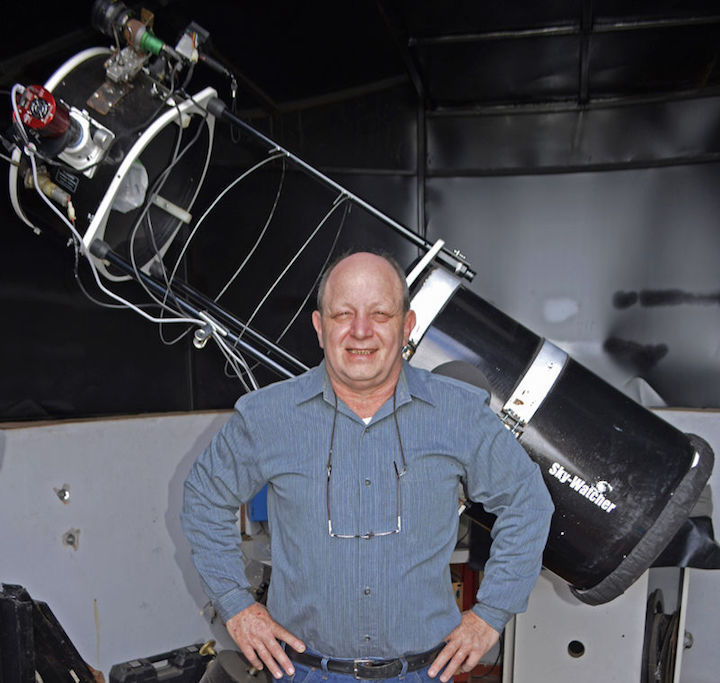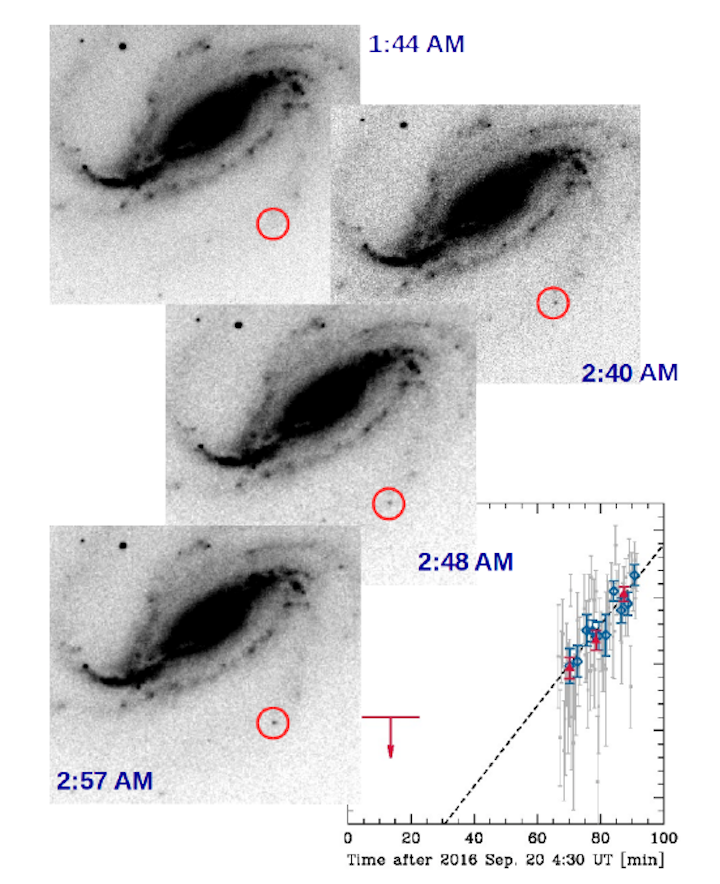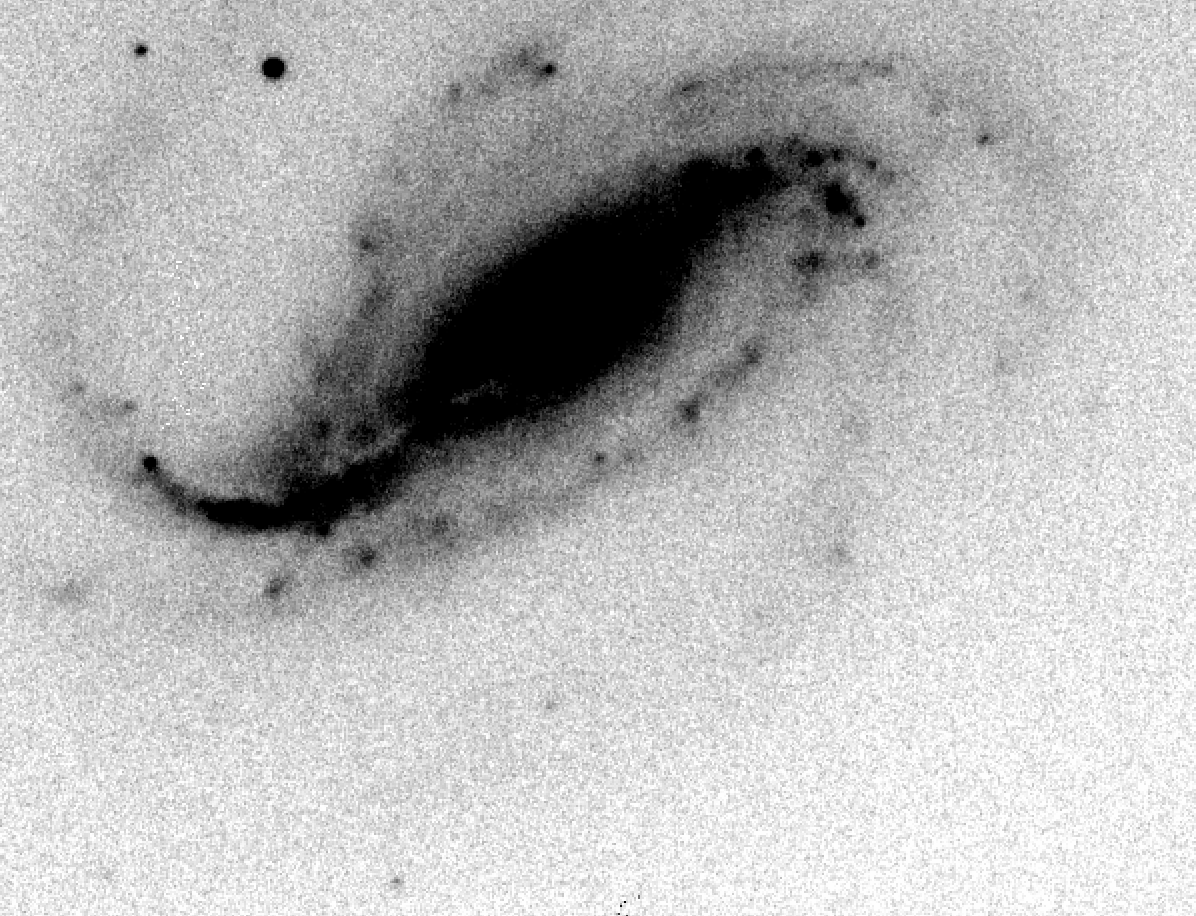22.02.2018
Images taken in Argentina track earliest stages in a stellar explosion.

Victor Buso at the rooftop observatory in which he captured the first images of the early stages of the birth of a supernova.
-
Victor Buso was eager to use the new camera on his telescope. But the amateur astronomer didn’t want to disturb his neighbours with the loud noise of opening his rooftop observatory, so he pointed his telescope through a gap in the enclosure on the night of 20 September 2016.
He trained it on a spiral galaxy called NGC 613, which is around 26 million parsecs (85 million light years) away in the southern sky, and spotted a rapidly brightening blotch of light in the series of images he was taking. Buso and a team of professional astronomers now report in Nature what seems to be the first observation of the very early stages of a supernova1.
The detection was “amazing”, says Norbert Langer, an astrophysicist at the University of Bonn in Germany. The chance of catching this event is smaller than that of hitting the jackpot in a lottery, he says.
The type of supernova the team observed occurs when a massive star runs out of nuclear-fusion fuel in its core. The star then begins to collapse, which compresses protons and electrons together and converts them into neutrons. Astrophysicists theorize that this collapse triggers a shockwave that can take up to a day to reach the star’s surface.
Astronomers have previously seen a supernova around 3 hours after the shockwave reached the surface. However, by taking a series of 20-second exposures over 90 minutes, Buso captured for the first time the rapid increase in brightness that is predicted to occur as the shockwave breaks free.
Buso says that he routinely compares the images he takes from his home in Rosario, Argentina, with online archival photos from other observatories. But that night, he saw differences not just between his pictures and the archive, but also between his first pictures and the ones he took over the course of the next 90 minutes. He thought, “Oh my God, what is this?”, he says.
A superimposed series of images show the supernova as a faint but rapidly brightening object to the south of the host galaxy, NGC 613.Víctor Buso and Gastón Folatelli
With the help of a friend, Buso immediately reported his discovery to the International Astronomical Union, a body of professional astronomers. It alerted its members around the world, some of whom rushed to study the supernova.
Catching the supernova so early should mean that astrophysicists can now check their models of how and why supernovas happen, says Langer. For the moment, the Nature paper contains only preliminary findings.
In the near future, projects such as the recently commissioned Zwicky Transient Facility at Palomar Observatory in California might make such early detection commonplace, says astronomer Avishay Gal-Yam of the Weizmann Institute of Science in Rehovot, Israel.
Meanwhile Buso, who spends his days working as a locksmith and many of his nights at his telescope, says that the discovery has made him feel that his efforts were worthwhile. “Many times, you ask yourself, ‘Why do I do this?’ Now I have found the answer.”
Quelle: nature
---
Update: 22.02.2018
.
Amateur Astronomer Captures Rare First Light of Massive Exploding Star

CREDIT: W. ZHENG/A. FILIPPENKO (UC BERKELEY)
Observations of supernova "SN 2016gkg" taken with the Katzman Automatic Imaging Telescope (KAIT) at Lick Observatory.
-

CREDIT: V. BUSO, M. BERSTEN, ET AL.
Sequence of combined images (negatives, so black corresponds to bright) obtained by Víctor Buso as SN 2016gkg appears and brightens in the outskirts of the spiral galaxy NGC 613. Labels indicate the time each image was taken. The object steadily brightens for about 25 minutes, as shown quantitatively in the lower-right panel.
-
Maunakea, Hawaii – Thanks to lucky snapshots taken by an amateur astronomer in Argentina, scientists have obtained their first view of the initial burst of light from the explosion of a massive star.
During tests of a new camera, Víctor Buso captured images of a distant galaxy before and after the supernova's "shock breakout" – when a supersonic pressure wave from the exploding core of the star hits and heats gas at the star’s surface to a very high temperature, causing it to emit light and rapidly brighten.
To date, no one has been able to capture the "first optical light" from a normal supernova (one not associated with a gamma-ray or x-ray burst), since stars explode seemingly at random in the sky and the light from shock breakout is fleeting. The new data provide important clues to the physical structure of the star just before its catastrophic demise and to the nature of the explosion itself.
"Professional astronomers have long been searching for such an event," said UC Berkeley astronomer Alex Filippenko, who followed up the discovery with observations at the Lick and Keck observatories that proved critical to a detailed analysis of explosion, called SN 2016gkg. "Observations of stars in the first moments they begin exploding provide information that cannot be directly obtained in any other way."
"Buso’s data are exceptional," he added. "This is an outstanding example of a partnership between amateur and professional astronomers."
The discovery and results of follow-up observations from around the world will be published in the Feb. 22 issue of the journal Nature (and published online on Feb. 21).
On Sept. 20, 2016, Buso of Rosario, Argentina, was testing a new camera on his 16-inch telescope by taking a series of short-exposure photographs of the spiral galaxy NGC 613, which is about 80 million light years from Earth and located within the southern constellation Sculptor.
Luckily, he examined these images immediately and noticed a faint point of light quickly brightening near the end of a spiral arm that was not visible in his first set of images.
Astronomer Melina Bersten and her colleagues at the Instituto de Astrofísica de La Plata in Argentina soon learned of the serendipitous discovery and realized that Buso had caught a rare event, part of the first hour after light emerges from a massive exploding star.
She estimated Buso's chances of such a discovery, his first supernova, at one in 10 million or perhaps even as low as one in 100 million.
“It’s like winning the cosmic lottery,” said Filippenko.
Bersten immediately contacted an international group of astronomers to help conduct additional frequent observations of SN 2016gkg over the next two months, revealing more about the type of star that exploded and the nature of the explosion.
Filippenko and his colleagues obtained a series of seven spectra, where the light is broken up into its component colors, as in a rainbow, with the Shane 3-meter telescope at the University of California’s Lick Observatory near San Jose, California.
The researchers also performed spectroscopic observations using the Low Resolution Imaging Spectrometer (LRIS) and the DEep Imaging and Multi-Object Spectrograph (DEIMOS) at W. M. Keck Observatory on Maunakea, Hawaii.
The data allowed the international team to determine that the explosion was a Type IIb supernova: the explosion of a massive star that had previously lost most of its hydrogen envelope, a species of exploding star first observationally identified by Filippenko in 1987.
Combining the data with theoretical models, the team estimated that the initial mass of the star was about 20 times the mass of our sun, though it lost most of its mass, probably to a companion star, and slimmed down to about five solar masses prior to exploding.
Filippenko’s team continued to monitor the supernova’s changing brightness over two months with other Lick telescopes: the 0.76-meter Katzman Automatic Imaging Telescope and the 1- meter Nickel telescope.
“The Lick spectra, obtained with just a 3-meter telescope, are of outstanding quality in part because of a recent major upgrade to the Kast spectrograph, made possible by the Heising- Simons Foundation as well as William and Marina Kast,” Filippenko said.
Filippenko’s group, which included numerous undergraduate students, is supported by the Christopher R. Redlich Fund, Gary and Cynthia Bengier, the TABASGO Foundation, the Sylvia and Jim Katzman Foundation, many individual donors, the Miller Institute for Basic Research in Science and NASA through the Space Telescope Science Institute. Research at Lick Observatory is partially supported by a generous gift from Google.

CREDIT: C. KILPATRICK (UC SANTA CRUZ) AND CARNEGIE INSTITUTION FOR SCIENCE, LAS CAMPANAS OBSERVATORY, CHILE
Supernova 2016gkg in spiral galaxy NGC 613; color image taken by a group of UC Santa Cruz astronomers on Feb. 18, 2017, with the 1-meter Swope telescope.
ABOUT LRIS
The Low Resolution Imaging Spectrometer (LRIS) is a faint-light instrument capable of taking spectra and images of the most distant known objects in the universe. The instrument is equipped with a red arm and a blue arm to explore stellar populations of distant galaxies, active galactic nuclei, galactic clusters, and quasars. LRIS was used in observing distant supernovae by astronomers who received the Nobel Prize in Physics in 2011 for research determining that the universe was speeding up in its expansion. Support for LRIS was generously provided by Friends of Keck, including Change Happens Foundation and Mt. Cuba Astronomical Foundation.
ABOUT DEIMOS
The DEep Imaging and Multi-Object Spectrograph (DEIMOS) boasts the largest field of view (16.7arcmin by 5 arcmin) of any of the Keck Observatory instruments, and the largest number of pixels (64 Mpix). It is used primarily in its multi-object mode, obtaining simultaneous spectra of up to 130 galaxies or stars. Astronomers study fields of distant galaxies with DEIMOS, efficiently probing the most distant corners of the universe with high sensitivity. Support for DEIMOS was generously provided by the National Science Foundation.
ABOUT W. M. KECK OBSERVATORY
The W. M. Keck Observatory telescopes are among the most scientifically productive on Earth. The two, 10-meter optical/infrared telescopes on the summit of Maunakea on the Island of Hawaii feature a suite of advanced instruments including imagers, multi-object spectrographs, high-resolution spectrographs, integral-field spectrometers, and world-leading laser guide star adaptive optics systems.
The data presented herein were obtained at Keck Observatory, which is a private 501(c) 3 non-profit organization operated as a scientific partnership among the California Institute of Technology, the University of California, and the National Aeronautics and Space Administration. The Observatory was made possible by the generous financial support of the W. M. Keck Foundation.
The authors wish to recognize and acknowledge the very significant cultural role and reverence that the summit of Maunakea has always had within the Native Hawaiian community. We are most fortunate to have the opportunity to conduct observations from this mountain.
Quelle: W. M. Keck Observatory

